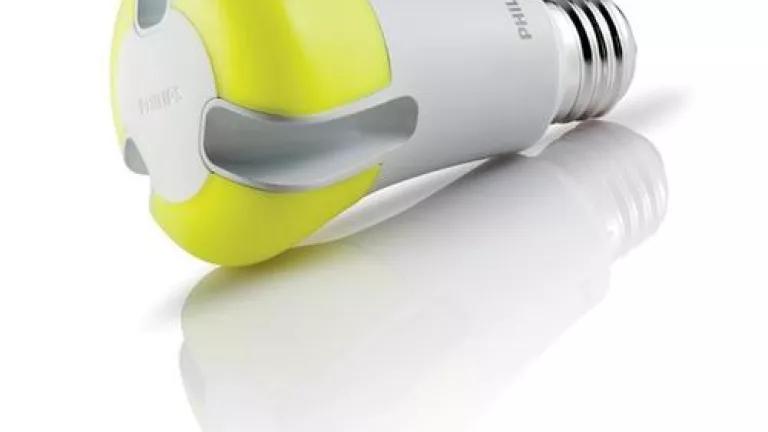
The Washington Post just ran a story describing the winner of the L Prize, a new LED light bulb that uses only one sixth the electricity of a standard incandescent. If you haven’t seen one, it looks like it was designed by Steve Jobs and it feels like the future.
The L Prize bulb (pictured below) is remarkable. It is a bright, long-lasting, affordable, light bulb with great light quality. What’s more, the L Prize bulbs are assembled in Wisconsin using computer chips made in California which makes the L Prize bulb the leading edge of a U.S. growth industry.
What’s remarkable about the Washington Post article is that the accompanying graphic made a basic math error. The graphic compared the cost of the L Prize bulb and the incandescent bulbs using an electricity price of one cent/kWh. The actual national average price of electricity is 12 cents/kWh, more than 10 times higher. This mistake dramatically understates the value of the saved electricity and the benefits of the L Prize bulb.
The Washington Post has since corrected the graphic to show the real bottom line. The Post analysis now concludes that each L Prize bulb will save users $145 at the national average electricity rate over the bulb’s lifetime. Particularly for consumers with high rates or long operating hours like restaurants and retail, the L Prize bulbs can provide many thousands of dollars in savings.
As my colleagues have described, the goal of the L Prize is to stimulate innovation and technology development, which NRDC – an L Prize Partner – sees as critical to meeting our environmental and economic challenges.
In order to win the L Prize, Philips had to meet a set of extremely challenging performance standards governing durability, reliability and performance. These requirements mean that the L Prize bulbs are going to be relatively expensive to buy at first, though – as the Post now acknowledges – they’re already cost effective.
Fortunately, for people who don’t want to plunk down $50 for a light bulb, there are many bulb choices on the market today that are more efficient than yesteryear's old fashioned incandescents. Consumers who want more efficient bulbs can choose from a wide array of types and brands of efficient bulbs, many of which cost only a buck or so including efficient incandescents (they look just like old fashioned bulbs but use 25-30 percent less electricity), CFLs and an increasing number of LED bulbs. These new bulbs are going to save consumers billions in lower electric bills and reduced pollution.
I also find it remarkable that some pundits have leapt onto an anti-efficiency bandwagon based on the erroneous version of the Post graphic, proclaiming the L Prize bulb another example of costly government interference in energy markets. They must have been surprised when the wheels fell off the bandwagon as soon as it started rolling. To paraphrase a common saying, efficiency opponents are entitled to their own opinions, but they aren’t entitled to their own math.
My advice? When the L Prize bulb arrives at your local hardware store or big box retailer in a couple weeks, go out and buy one. Or two or three. Save yourself a couple hundred dollars. See what the future looks like. And stand up for good math.
